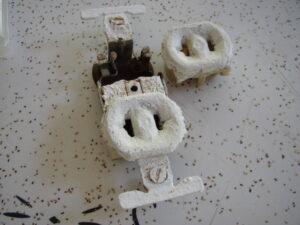As is often the case with these things, I hit a snag trying to fish wire from the attic to the basement for my bedroom rewiring project. I encountered some horizontal blocking in the stud cavity which prevented me from running the wire all the way through. That basically left me with three choices:
- Press forward and try to run the wire through the cavity as planned, turning most of my hair gray and losing several years from my life expectancy in the process;
- Try to find an alternate stud cavity to run my wire; or
- Come up with another plan altogether.
I’ll admit, I briefly considered #1. I’ve fished wire through some tight spots in my day, and if I’m determined enough, I could get the wire through, horizontal blocking and all. But if there’s an easier way, I’d rather not deal with the frustration.
#2 might work. I fished wire through a different stud cavity for a similar project a couple years back, and had no problems. But it’s really kind of a crap shoot, and I’d rather not drill tons of holes all over the place just to find a clear shot from the attic to the basement.
All this brings us to #3. After consideration, I decided to tap into some existing wiring in the basement instead. It turns out there’s a nearby circuit that has only a single outlet on it (used to be for a window air conditioner). So I’m going to tie the wiring into this circuit. Simpler and easier than trying to fish through the wall.
Moral of the story: the first plan you come up with is not necessarily the best or easiest, so don’t get set on it.
